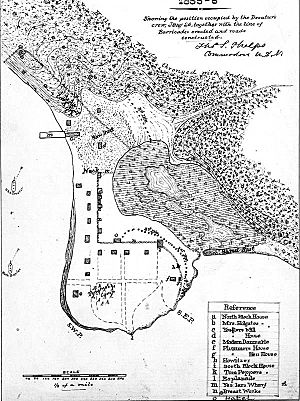Puget Sound War facts for kids
Quick facts for kids Puget Sound War |
|||||||
|---|---|---|---|---|---|---|---|
| Part of the American Indian Wars | |||||||
 A map of Seattle, drawn at the time of the Battle of Seattle, part of the Puget Sound War. Map shows the sloop USS Decatur and the bark Brontes in Elliott Bay |
|||||||
|
|||||||
| Belligerents | |||||||
Snoqualmie |
Nisqually Muckleshoot Puyallup Klickitat |
||||||
| Commanders and leaders | |||||||
| Chief Leschi | |||||||
| Units involved | |||||||
| 9th US Infantry 3rd US Artillery 4th US Infantry USS Decatur Snoqualmie warriors Washington militia Oregon militia |
Nisqually warriors Muckleshoot warriors Puyallup warriors Klickitat warriors |
||||||
The Puget Sound War was a conflict in the Puget Sound area of Washington from 1855 to 1856. It involved the U.S. military and local groups fighting against Native American tribes. These tribes included the Nisqually, Muckleshoot, Puyallup, and Klickitat. Also, Haida and Tlingit raiders clashed with the United States Navy.
This conflict was not very large in terms of land or lives lost. However, it is often remembered for the 1856 Battle of Seattle. It is also known for the trial and execution of a key Native American leader, Chief Leschi of the Nisqually tribe. Some events of the Puget Sound War, like the Battle of Seattle, might have been connected to the Yakima War. People at the time did not always see these two conflicts as separate.
Contents
Causes of the Puget Sound War
The Puget Sound War started because of disagreements over land rights. It ended with a lot of debate about Chief Leschi's execution.
The Treaty of Medicine Creek
A major reason for the war was the Treaty of Medicine Creek from 1854. Washington Territory Governor Isaac Stevens led the talks for this treaty. The treaty allowed Native Americans to keep their fishing rights. However, it took away important farmland from the Nisqually people.
Chief Leschi was chosen to represent his people in these treaty talks. He was very upset by the terms of the treaty. He decided to fight for his people's land instead of giving it up.
Key Events and Battles
Fighting began in October 1855. A group of citizen soldiers called "Eaton's Rangers" clashed with Nisqually tribesmen. Two of the soldiers were killed. When Governor Stevens heard this news, he sent troops to find Leschi. He wanted them to bring Leschi back to Olympia.
Early Skirmishes and Attacks
The war involved several small battles. Not many American lives were lost in these fights. Important battles happened in areas that are now Tacoma, Seattle, and even as far east as Walla Walla.
On October 28, 1855, a group of Native Americans killed eight settlers. This event was later called the White River Massacre. Three children escaped to Seattle. However, a five-year-old boy was taken by the Native Americans. He was held for six months before being released.
Another report says that a Nisqually group led by Chief Leschi was responsible. It stated that nine settlers were killed. Two boys and a girl were taken but later returned safely to an American boat. Some accounts say that families were warned to leave beforehand. One memoir noted, "The Indians sent us word not to be afraid - that they would not harm us." Some of the families included members of volunteer groups. These groups had been attacking peaceful Native Americans in the area.
Holding Non-Combatants
After the attack at White River, American forces captured about 4,000 Native Americans. These were people who were not fighting. They were held on Fox Island. Many of them died because they did not have enough food, water, or shelter.
Also, American forces raided tribes in the southwest. These tribes had no history of warfare. They were disarmed, and their villages were watched. Families from the Upper and Lower Chehalis tribes were forced to move to a farm near Steilacoom. Coastal tribes like the Cowlitz were moved to a place on the Chehalis River. The Chinook people were moved inland to Fort Vancouver. All these groups remained captive for almost two years, until the war ended.
The Final Battle
The last major battle of the war happened around March 10, 1856. About 110 volunteers from the Washington Territorial Volunteers were attacked near Connell's Prairie. The Native American force was estimated to be 150 warriors. It was believed that Chief Leschi led them. After several hours of fighting, the Native Americans pulled back. After this battle, Leschi and his remaining warriors went over the Cascade Mountains into Eastern Washington.
Chief Leschi's Trial and Legacy
Chief Leschi was captured in November 1856. He was put on trial for the death of Abram Benton Moses.
The Trials of Leschi
Leschi's first trial ended with a hung jury. This means the jury could not agree on a verdict. The main question was whether it was right to charge someone with murder during a time of war. Ten jurors voted for conviction, but two voted against it.
Leschi was tried again in 1857. The witness accounts were not very clear. There were also questions about whether Leschi was actually at the scene of the incident. Despite these issues, he was found guilty. Leschi was executed on February 19, 1858.
Leschi's Exoneration
On December 10, 2004, a special historical court met in Pierce County, Washington. This court decided that Leschi was a "legal combatant" in the war. This meant he should not have been held responsible for the death of an enemy soldier. This ruling cleared his name.
Today, the Leschi neighborhood in Seattle is named after him. The Chief Leschi Schools on the Puyallup Indian Reservation also carry his name.

